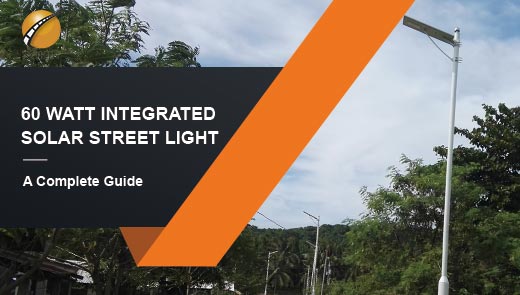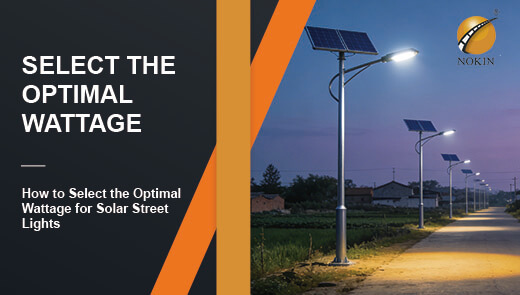Different types of street lights and their applications
In modern society, street lighting is an important part of urban and rural infrastructure, not only illuminates our travel path, but also provides a strong guarantee for public safety. With the continuous development of lighting technology, the types of street lights are becoming more and more abundant, and each type has its unique characteristics and applicable scenes. In this article, we will discuss the different types of street lights and their applications in various scenarios to help readers make informed decisions when undertaking outdoor lighting projects.
Understanding Different Types of Street Lights
LED Street Lights
LED Technology Principles
LEDs (light-emitting diodes) are semiconductor devices in which electrons and holes in the semiconductor compound when an electric current is passed, releasing energy in the form of light. Unlike traditional lighting sources, LEDs do not rely on thermal radiation to emit light, but are based on the electron migration principle of semiconductors. This unique way of emitting light allows LEDs to show many advantages in street lighting applications.
Remarkable Advantages
-Energy saving and high efficiency: Compared with traditional street lights, LED street lights consume significantly less energy, which can effectively reduce operating costs, but also fits the concept of environmental protection and contributes to sustainable development.
-Long life: LED street lights can last for 25,000 to 100,000 hours, far longer than incandescent and fluorescent lamps, which greatly reduces the frequency of maintenance and replacement.
-Instant-On: No warm-up time is required, and the light comes on instantly, providing adequate illumination for roadways and improving safety.
-Directional Lighting: Light is emitted in a specific direction, reducing light pollution and enabling precise coverage of the required area.
-Excellent color reproduction: excellent color reproduction ability, can truly present the object and environment color, help to identify pedestrians and objects, enhance safety and security.
-Adjustable brightness: Most LED street lights support brightness adjustment, which can be flexibly adjusted according to the actual demand, further realizing energy saving.
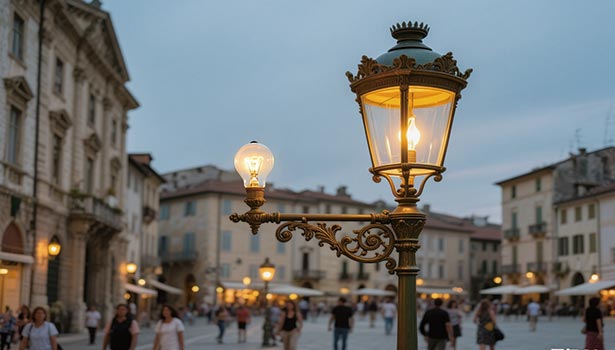
Traditional Street Lights
Overview of Traditional Street Lights
In the past, incandescent and fluorescent lamps were the main choices for street lights, which played an important role in urban and rural road lighting and were used by many municipalities for a long time.
Applications and Limitations
|
Types |
Application Scenarios |
Disadvantages |
|
Incandescent |
Once widely used in street lighting to create a familiar atmosphere with its warm and soft light |
High energy consumption and short service life, gradually eliminated in the face of increasingly stringent energy costs and environmental protection |
|
Fluorescent |
To a certain extent, it has been used in many municipal departments for a long time.
|
Delayed start-up and flickering may occur in some products, affecting the lighting experience and visual comfort |
Specialty Lighting: Mercury Vapor and Metal Halide Lamps
Niche but Important Types of Street Lighting
Mercury vapor lamps and metal halide lamps are not as popular as LED street lamps, but they still have an irreplaceable role in specific scenarios.
Applicable Scenarios and Advantages
-Mercury vapor lamps: commonly used in industrial areas, large parking lots and other places with high light intensity and coverage requirements. Its high luminous efficiency, long life, can provide stable lighting for large areas.
Metal halide lamps: suitable for sports venues, shopping centers and other places that require high-quality lighting, with excellent color rendering and high brightness, can clearly show the details and colors of the object.
Different applications of types of street lights
Street lighting
Difference in demand between urban and rural streets
Urban streets have high traffic flow and many pedestrians, which require high brightness, uniformity and color rendering of street lights; rural roads pay more attention to energy saving and meeting basic lighting needs, while considering the cost factor.
Applicability of LED street light
LED street lights have become the ideal choice for urban and rural street lighting due to their energy-saving, long-life and adjustable luminous efficacy. Whether it is the main road in the busy city or the quiet countryside, it can provide suitable lighting solutions.
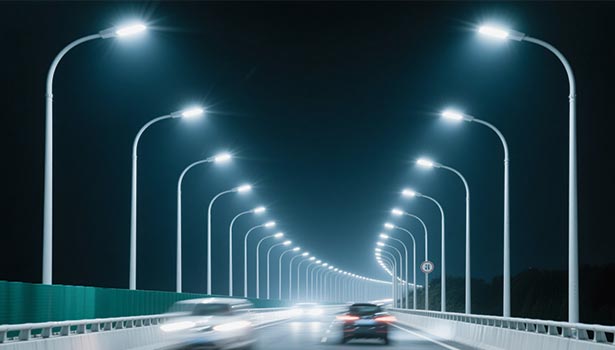
Highway Lighting
Regular situation: highways are usually not installed street lights, on the one hand, because of the high construction and maintenance costs, on the other hand, too many street lights may cause visual interference to long-distance drivers, and some sections of the surrounding environment is open, natural light conditions are better.
Special area lighting: In key areas such as highway entrances and exits, bridges, traffic circles, etc., high-power street lights or floodlights need to be installed to ensure that drivers can have a good view of these complex road sections and ensure driving safety.
Intersection Lighting
Intersection is a key node of traffic intersection, drivers need to quickly observe the road conditions and make judgments, LED street lights installed at appropriate intervals, can provide uniform lighting, to avoid uneven light caused by visual fatigue. If necessary, high-pole lamps can be set up to illuminate the intersection area in an all-round way to ensure the safe passage of pedestrians and vehicles.
Plaza Lighting
Plaza is an important place for people to relax at night, the lighting should not only meet the basic brightness, but also to create a comfortable atmosphere. LED area lights and LED flood lights are commonly used options, some LED street light manufacturers have also developed a light distribution scheme suitable for plaza lighting, which not only reduces the cost, but also enriches the functionality of the product.
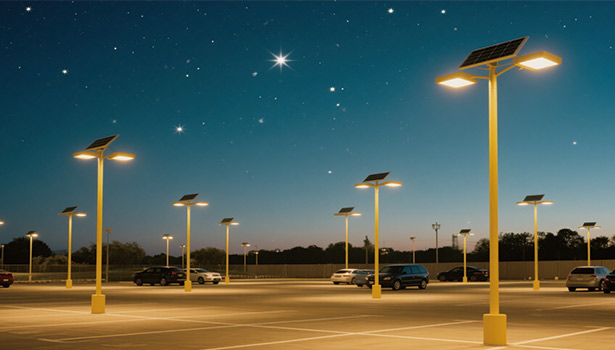
Parking Lot Lighting
With the increase of car ownership, parking lot lighting is crucial, solar street lights and post roof lights can provide bright, energy-saving lighting for parking lots, and there are a variety of mounting options, such as straight arm pole mounting, adjustable skid mounting, wall mounting, etc., to meet the needs of different parking lots.
Outdoor industrial and logistics area lighting
Large warehouses, logistics parks and other places have a vast area and frequent night operations. Adequate lighting can eliminate blind spots and ensure the safety of vehicle traveling and cargo loading and unloading. Metal halide lamps or high-power LED floodlights can provide high-intensity lighting to meet the special needs of industrial and logistics areas.
Non-motorized and Sidewalk Lighting
Non-motorized tracks and sidewalks are the main traffic areas for pedestrians and non-motorized vehicles, and the lighting design is usually combined with roadway lighting. Dedicated street lights provide safe and comfortable lighting for this area, helping pedestrians to see and recognize each other, and preventing criminal behavior.
Customer concerns about types of street lights
Street Light Wattage
Wattage is a key factor in choosing street lights. The higher the wattage, the better the lighting effect when the pole height, road width, pole spacing and other conditions are fixed. Selection of LED street light wattage can start from three aspects: reference to the existing lamp type and wattage, such as 250W high-pressure sodium lamps can be replaced by 100W LED lamps; based on the installation height of the lamps and lanterns to choose; according to the professional lighting design to determine.
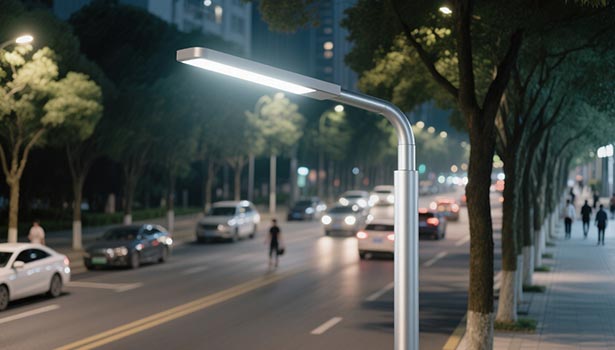
Street light efficiency
Light efficiency is an important indicator of LED lamps. With the development of technology, the luminous efficacy of LED street lamps has been improving, and now it can reach 150lm/W, which can realize the same lighting effect with lower power compared with earlier products. High luminous efficiency means lower energy consumption. In many projects and tenders, luminous efficiency is an important criterion for consideration, and high-efficiency products are more competitive.
Optical Design of Street Lights
As different roads and scenes require different lighting angles and coverage, LED street lights need to have flexible optical designs to adapt to a variety of environments, such as city roads, countryside paths, and parking lots. For example, NOKIN's LED street lights offer a wide light distribution design to achieve good light uniformity in various scenarios.
Color Rendering Index and Color Temperature
Color Rendering Index (CRI): Measures the ability of a light source to reproduce the true color of an object, with a maximum value of 100. For LED street lights, a CRI of 70 usually meets the basic needs, while a CRI of 80 can better render the color of an object.
Color Temperature (CCT): Used to describe the color characteristics of the light source, the unit of Kelvin (K). 2700K for warm tones, 4000K for neutral tones, 5700K for cool tones. Nowadays, roadway lighting is more and more inclined to lower color temperatures because it has less impact on humans, plants and animals.
Street Lighting Certification
Certification is a strong indication that a product complies with standards. In terms of safety standards, common requirements such as CE and RoHS certification are required for LED street lights; ENEC certification is sometimes required in Europe, and CB certification may be needed in other regions. In terms of product parameters, luminous efficacy, heat dissipation, waterproof and other properties correspond to LM79, ISTMT, IP and other reports. For factory qualification, ISO9001 is a common standard, and NOKIN also provides ISO14001, ISO45001 and other certifications.
Street Light Price
The price of street light is affected by various factors such as type, material, technology, project requirements, etc. NOKIN offers a wide range of street light products with different designs and prices to meet different budgets of customers, so that customers can make reasonable choices according to their project budgets.

